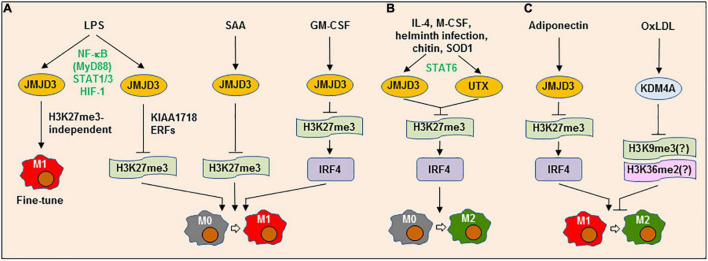FIGURE 2.
Lysine demethylases can play dual roles in both M1 and M2 polarization or M1→M2 repolarization. (A) LPS up-regulates the lysine demethylase (KDM) jumonji domain-containing (JMJD3) (KDM6B) via a process involving multiple transcription factors (e.g., NF-κB/MyD88, STAT1/3, and HIF-1), which in turn acts to either fine-tune M1 phenotype via an H3K27me3-independent process or promote M1 polarization, which requires another KDM KIAA1718 and elongation-regulatory factors (ERFs). Similarly, JMJD3 is involved in M1-like polarization induced by serum amyloid A (SAA) or granulocyte-macrophage colony-stimulating factor (GM-CSF) by up-regulating IRF4 via H3K27me3. (B) Alternatively, multiple factors (e.g., IL-4, M-CSF, helminth infection, chitin, and SOD1) can induce JMJD3 and UTX (KDM6A) expression via STAT6, which in turn mediate M2 polarization by up-regulating IRF4 via H3K27me3. (C) JMJD3 may promote adiponectin-triggered repolarization from M1-like to M2-like phenotype, likely via the similar mechanism involving H3K27me3-depdendent IRF4 expression. On the contrary, oxLDL induces the expression of KDM4A (JMJD2A), another member of the JMJD demethylase family, which blocks the repolarization from M1-like to M2-like phenotype, an event that can be restored by KDM4A deficiency or inhibition. LPS, lipopolysaccharide; JMJD3, Jumonji domain-containing protein 3; NF-κB, nuclear factor kappa-light-chain-enhancer of activated B cells; STAT, signal transducer and activator of transcription; HIF-1, hypoxia-inducible factor 1; IRF4, interferon regulatory factor 4; IL-4, interleukin-4; M-CSF, macrophage colony-stimulating factor; SOD1, superoxide dismutase 1; oxLDL, oxidized low-density lipoprotein; KDM4A, lysine demethylase 4A.

